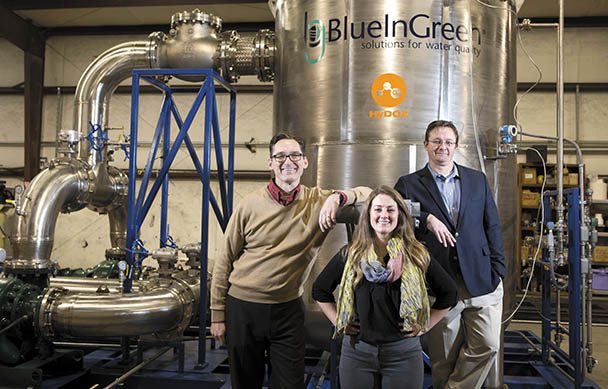BlueInGreen Is Growing Up
by January 5, 2015 12:00 am 400 views

Fayetteville-based water technology firm BlueInGreen LLC is growing up.
The company announced Nov. 20 that it — along with project partners Pinnacle Ozone Solutions LLC of Florida and PCI Inc. of California — was partnering with the city of Fayetteville to provide an innovative new ozone disinfection system to more effectively and efficiently clean the city’s wastewater before it is discharged back into the White River.
Fayetteville’s one-time capital purchase of BlueInGreen’s gas dissolution system HyDOZ was $1.78 million — more than twice the amount of BlueInGreen’s biggest sale since its first water disinfection product, SDOX, was installed in 2008.
“It’s a game-changer for us financially,” said Vance Clement, the company’s vice president of sales and marketing since November 2013.
The purchase also capped a breakthrough year for BlueInGreen, which was founded in 2004 by University of Arkansas professors Scott Osborn and Marty Matlock. It garnered $4.2 million in purchase orders in 2014, which led to a profitable fourth quarter, the company’s first.
“And next quarter will be [profitable] as well,” said CEO Clete Brewer. “I think you’re in startup mode until you are profitable, and I think we finally turned the corner on that this quarter.”
The partnership could also be a breakthrough for Fayetteville, which will be the first city in Arkansas using ozone to treat wastewater.
“They will have the cleanest wastewater effluent in the state of Arkansas — by far,” Brewer said. “It will look like drinking water.”
Product Expansion
BlueInGreen was founded a decade ago with a goal of revolutionizing the way oxygen is used to treat water and wastewater.
Since its first product installation in 2008, the company has completed more than 20 installations and has expanded its offerings to include four separate products using not only oxygen, but also carbon dioxide and ozone.
Last year alone, BlueInGreen expanded its installed base 33 percent — it now has products in eight states — and grew its revenue by more than 200 percent.
Construction and installation of the HyDOZ system will be completed in a few months at the Noland Wastewater Treatment Plant in Fayetteville.
Clement said ozone has long been known to be a better oxidizing agent than ultraviolet (UV) disinfection. But in regard to wastewater treatment, it’s been more expensive.
He and Brewer believe, however, the company’s proprietary technology will integrate ozone into wastewater in a more competitive way, from both a cost perspective and an efficiency perspective.
Billy Ammons agrees. Ammons is a vice president at CH2M Hill, a global engineering firm that manages the wastewater services for the city of Fayetteville. He expects the operating costs to be similar to the UV disinfection currently used, but the environmental benefit will be much greater.
He said ozone will not only kill the basic contaminants (E.coli, fecal contaminants), it will be more effective than UV at killing emerging contaminants of concern (ECCs) including pesticides, hormones and pharmaceutical compounds
“This technology will provide an extremely highly oxygenated discharge stream, which the current aquatic life will enjoy,” he said. “It’ll be like a treat for all the different types of life that are in that receiving stream [White River].”
Ozone Uprising
Brewer said as recently as four years ago there was only one wastewater plant in the United States using ozone. Now there are 10, and the Noland facility will be among the next 10.
That number is expected to grow, and if the Environmental Protection Agency decides to regulate ECCs in the future, BlueInGreen is well-positioned to capitalize on the opportunity.
And demand from U.S. municipalities should only increase, Brewer said, as pent-up demand from a slower economy (2008 to 2011) has delayed capital-intensive projects that need to be completed.
Worldwide water and wastewater management expenditures totaled more than $560 billion in 2010, with $114 billion of that in the U.S.
“Ozone is getting much more acceptance on the market right now, and this puts us right in the thick of it,” he said. “There’s only a few ways of injecting ozone into water. One is through a diffuser, the other is an injector system and now there is the BlueInGreen system. We’re one of three choices and we believe our economic value is better than the others. So, we think anybody looking at ozone systems will be looking at our system as a way of injecting their water.”
And from an environmental standpoint, Clement believes the people of Fayetteville will be proud that their city is doing something from an ecological standpoint that will further benefit the environment.
“The saying we use in the water business is ‘everybody lives downstream,’” he explained. “If it’s not Fayetteville’s water, it’s the next city down that will be getting our emerging contaminants of concern. It’s always good to know you’ve gotten rid of those when a mile down the river, you’re going to be pulling that back in for drinking water.”
